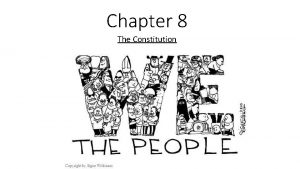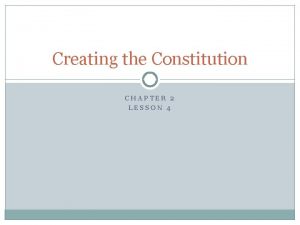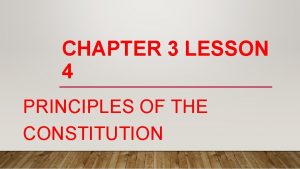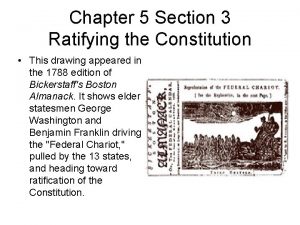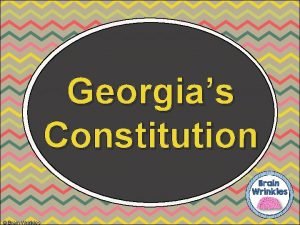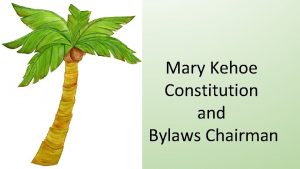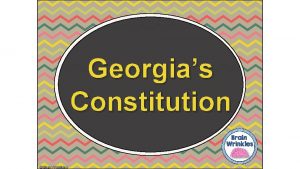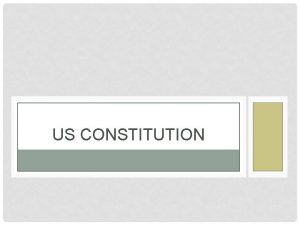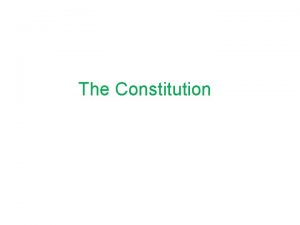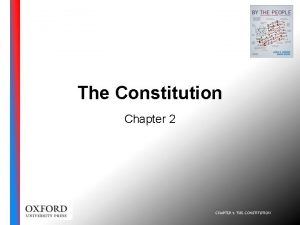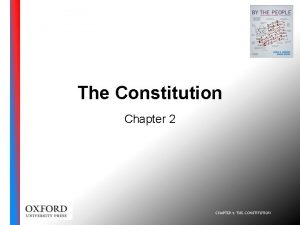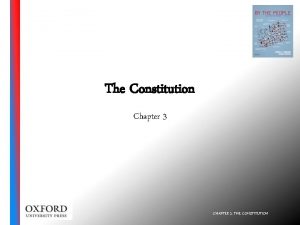Chapter 8 The Constitution Lesson 1 The Constitution










- Slides: 10

Chapter 8 The Constitution

Lesson 1 • The Constitution is based on seven key principles. These principles are: popular sovereignty, republicanism, limited government, federalism, separation of powers, checks and balances, and individual rights. The Constitution begins ‘We the People’ and creates a government for the people, by the people. • The basis of the government is popular sovereignty and republicanism, in which the people control the government through elected officials. Our Constitution gives certain powers to the federal government, and grants other powers to the state governments. This sharing of power is called federalism. • To prevent the government from becoming too powerful, the Constitution created three branches (legislative, executive, and judicial) of the federal government. A system of checks and balances was created to allow each branch to limit the power of the other branches. • The Constitution is referred to as a “flexible document. ” This means it can adapt and change as society and other circumstances require. The Framers of the Constitution included in it a way to change, or amend, it. Different interpretations of the Constitution’s implied powers also allow the document to change over time.

Federal System of Powers • Enumerated powers: those that are given to Congress only. • Reserved powers: those that belong to the states. These are not specifically listed in the Constitution. • Concurrent powers: powers that are shared by the federal and state governments. The states and the federal government can exercise these powers at the same time. • Implied powers: Those not specified by the Constitution.




Lesson 2 • The Constitution defines the roles of the legislative branch, executive branch, and judicial branch. Article I establishes the legislative branch. The legislative branch is made up of the Senate and the House of Representatives. It is the elected lawmaking body of government. • Article II establishes the executive branch. It is made up of the president, vice president, and president's cabinet. • Article III establishes the judicial branch, which consists of the U. S. Supreme Court, the Courts of Appeal, and the federal district courts. The Supreme Court is the top court in the U. S. legal system. The judicial system says what the law is, and decides if an issue is constitutional or not. • American citizens enjoy many rights defined in the Constitution. Those rights include freedom of speech, press, and religion, and the right to your life, liberty, and pursuit of happiness. People also have the right to due process in legal proceedings and equal protection under the law. • In addition to rights, citizens also have duties, or things they must do. Citizens also have responsibilities, or things they should do to help protect the rights of citizens and others. • Voting is perhaps the most important responsibility of a citizen. A citizen is a person who has the protection of a nation and also owes it loyalty. • There are different ways to become an American citizen. Being born on American soil is one way, while foreign-born people can become citizens by going through a formal process called naturalization.

• The U. S. Constitution has 27 Amendments • #1 -10 is the Bill of Rights, which protects individual freedoms


 Lesson 1 principles of the constitution
Lesson 1 principles of the constitution Texas constitution vs us constitution
Texas constitution vs us constitution Nc constitution vs us constitution
Nc constitution vs us constitution Constitution what is constitution
Constitution what is constitution Chapter 8 lesson 1 principles of the constitution
Chapter 8 lesson 1 principles of the constitution Chapter 7 lesson 2 forging a new constitution
Chapter 7 lesson 2 forging a new constitution Chapter 2 lesson 4 creating the constitution answer key
Chapter 2 lesson 4 creating the constitution answer key Lesson 4 principles of the constitution
Lesson 4 principles of the constitution Lesson 2 the three branches of government
Lesson 2 the three branches of government Overall state of well being or total health
Overall state of well being or total health Chapter 5 section 3 ratifying the constitution answer key
Chapter 5 section 3 ratifying the constitution answer key




